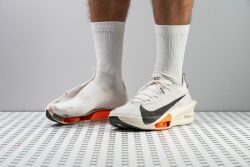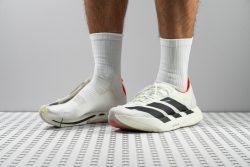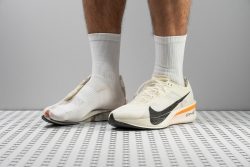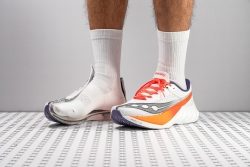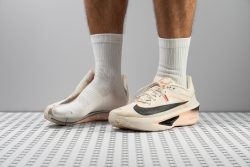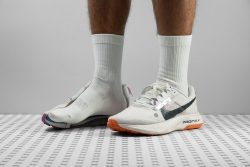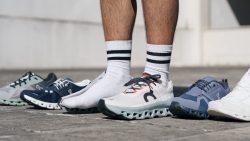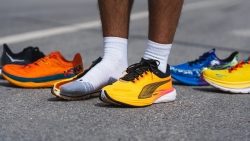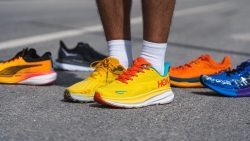7 Best Running Shoes With A Carbon Plate in 2025

We buy shoes ourselves. We earn commissions when you buy through us, at no extra cost. Why trust us
Welcome to the world of carbon-plated running shoes. When they first appeared, they were all everyone talked about. Now, enough time has passed for us to analyze the scientific articles, cut plenty of plated shoes in half, and look at what's inside to learn why some work better than others and to wear-test them in different surroundings.
Carbon plates are here to stay, both in trail shoes and road shoes. In this guide, we'll show you how they look like when cut out from the midsole, why and when they don't work as promised, and how to make sure your investment pays off.
How we test running shoes with a carbon plate
All the carbon-plated shoes we list here have been tested on runs and in the lab. We combine our personal experience with the shoe and our lab data to present you with the most objective reviews in the world. To make sure our reviews are not biased, we also buy all the shoes on our own—brands can not pay us to write about their shoes or tell us what to write.
Once the shoe gets onto our pipeline, we:
- Run in the shoe to experience how it fits, feels, and performs on the runs.
- Perform dozens of lab tests on the whole shoe
- Cut one shoe in half and then
- Perform the rest of the tests that can be done properly only on a shoe that has been cut in half.
Honoring this process, we end up with 20+ data points for each shoe, such as energy return. We present these findings in each review, where you can compare the results to those of other shoes of your choice.
Best carbon-plated running shoes overall










































































What makes it the best?
We pounded the pavement with the top carbon-plated shoes and found the Nike Alphafly 3 to be the best overall with its extraordinary ride. Featuring the FlyPlate and the Air Pods in the dynamic ZoomX midsole, it guarantees unrivaled energy return. Even at high speeds, our lab confirms it has a comforting and refreshing aura thanks to its innovative midsole design and airy build.
Each stride exudes electrifying energy effortlessly, proving it thrives at race pace from start to finish up to marathon/ultra distances. Further analysis reveals the Air Pods and stiff FlyPlate integrated into the midsole for consistent hyper-responsiveness. A3 shows unwavering resilience in our bend test, emerging 145.5% stiffer than average, resulting in massive power return.
Alphafly 3 offers excellent impact protection and revolutionary stability through its dual-density set-up. The ZoomX midsole measures 38.1/33.7 mm tall and is made of a plush 18.1 HA foam for comfort and another firm 29.3 HA layer for steady strides.
The shoe’s thrilling and agile ride comes from its featherweight 7.1 oz (201g) build. With a perfect breathability rating in the lab, its breezy Atomknit upper keeps us rejuvenated with seamless airflow.
However, this speedster comes at a staggering price of $285. PB-chasers who value every second will find A3 worth the investment. Otherwise, more affordable options are available elsewhere.
Pros
- Remarkably lightweight despite its broad size
- Best-in-class breathability
- Excels in the marathon distance
- Repositioned Air Pods offer a better ride than the v2
- ZoomX foam delivers massive energy return
- Aids in forward momentum, especially when legs begin to fatigue
- Better than ever for 5K/10K racing
- Finally smooth transitions!
Cons
- Heel strikers might wear down the outsole quickly
- The arch could still be a challenge for some
- The sock-like tongue might not suit everyone
Carbon-plated running shoes with the best energy return
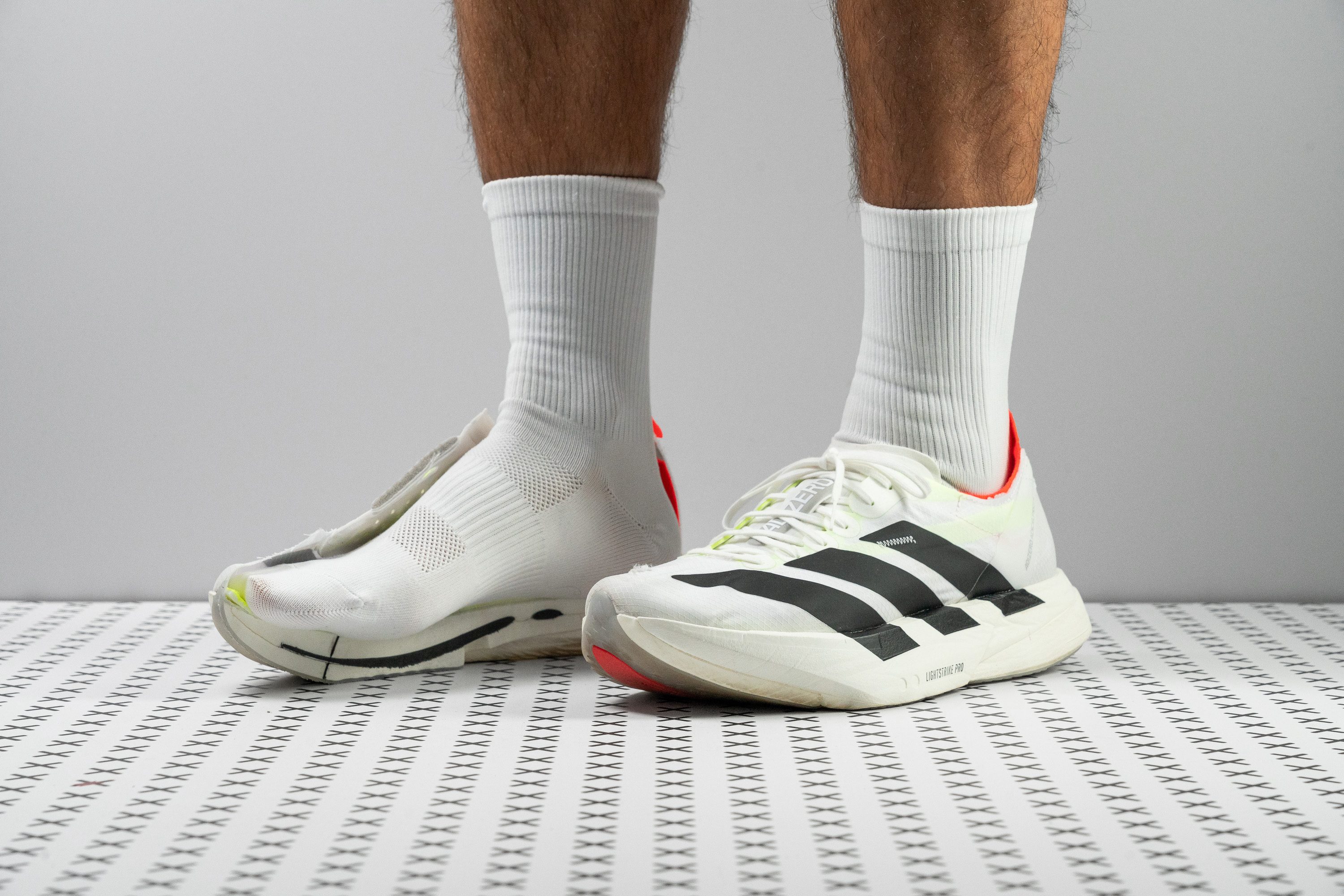



























































What makes it the best?
The Adizero Adios Pro 4 breaks the mold of typical racers and delivers exceptional security in our runs while offering limitless power. It feels thrillingly fast without compromising our comfort and safety. But based on our lab results, it smashes carbon-plate running shoes in terms of unmatched energy return.
The AP4’s cushioning is on another level. Both the heel and the forefoot smashed the lab average for energy return, with scores of 80.4% and 80.3%. No matter where we land, we’re sprung off by a highly responsive foam.
Additionally, it includes five carbon-infused rods that deliver the rigidity needed for more stable and responsive strides. Because it’s positioned based on our foot anatomy, it’s less rigid than typical supershoes. Our bend test confirms it needs 22.7N to reach 30 degrees, lower than other carbon-plated shoes.
While the AP4 is highly cushioned, it still offers surefooted strides for mid-to-forefoot strikers. The forefoot is a massive 118.8 mm, 4.5 mm above average, leaving no room for wobbly landings.
Unfortunately, the toebox tapers aggressively to the front and may feel restrictive for some. Runners with wide feet should look for a more accommodating pair. We also can’t recommend the AP4 to runners whose feet swell in long-distance runs.
Pros
- Softer, bouncier Lightstrike Pro foam
- Maintains the same price
- No more heel slippage
- Versatile from 5K to marathon distances
- Durable outsole with outstanding grip
- Fantastic for midfoot and forefoot strikers
- Improved for faster runners
- Comfortable, gusseted tongue
- Lighter than Adios Pro 3
Cons
- Unstable for every heel striker
- Narrow, tapered toebox
- Upper lacks breathability
- Midsole loses bounce quicker than AP3
Carbon-plated running shoes with the best shock absorption
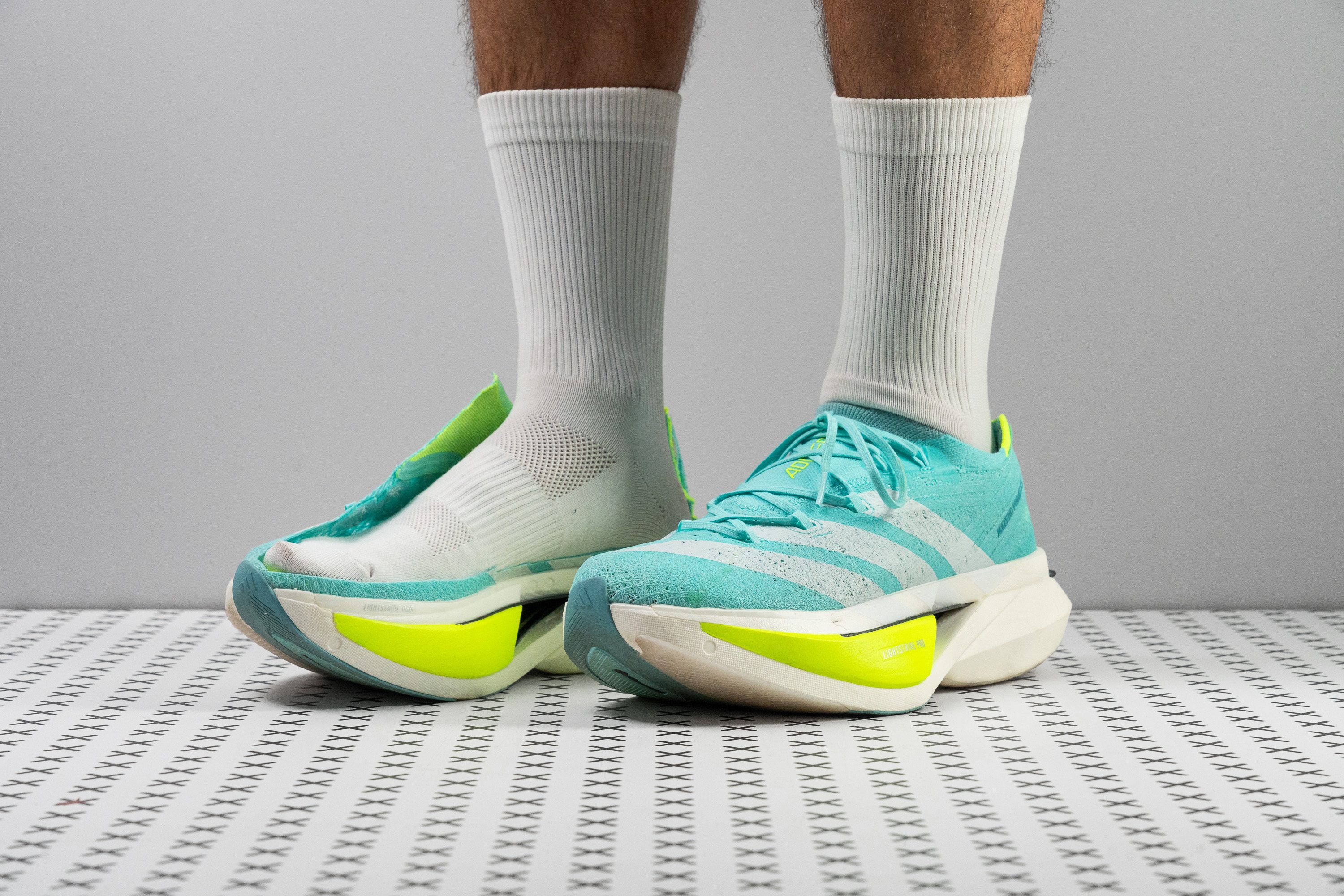





















































What makes it the best?
As soon as we wore the Adidas Adizero Prime X3 STRUNG, we instantly knew it was the carbon plate running shoe with the most leg-saving, shock-absorbing cushioning. For one, it obviously features a skyscraper stack, and our lab results coincide with our impression: the shoe holds a superior combination of height, softness, and rebound. What’s even better is that we can run without counting the miles as the carbon plate gives us the speed we need.
This shoe has one of the highest heel stack heights, boldly exceeding the 40-mm limit. Standing at 48.1/35.1 mm, it’s 13.7/9.3 mm higher than average! It’s impossible to run out of cushioning! Our feet reveled in the luscious foam, which our shock absorption test proves with solid 160/125 SA ratings. Just the heel alone offers 25.0% better impact protection than average.
To ensure speed, it features the dynamic Lightstrike Pro midsole, coupled with a full-length carbon plate and Energy Rods 2.0, maintaining our forward momentum seamlessly. We tested for the foam’s energy return, with results way above average at 73.7% in the heel and 76.7% in the forefoot.
While it surpasses supershoes in so many levels, it also exceeds in terms of weight. At 10.8 oz (305g), it’s too heavy to feel as agile as other racers.
Pros
- Excellent shock absorption
- Fantastic bounce from new Lightstrike Pro foam
- Fits better than v2
- Innovative tech and design from heel to toe
- STRUNG upper is just awesome
- Works well on any season
- Skyscraper-like stack height
- A total blast (if it suits you)
- Breathable upper
Cons
- Crazy expensive
- Heavier than all supershoes
- Heel strikers may feel unstable
- Too stiff for easy days
Best lightweight carbon-plated running shoes
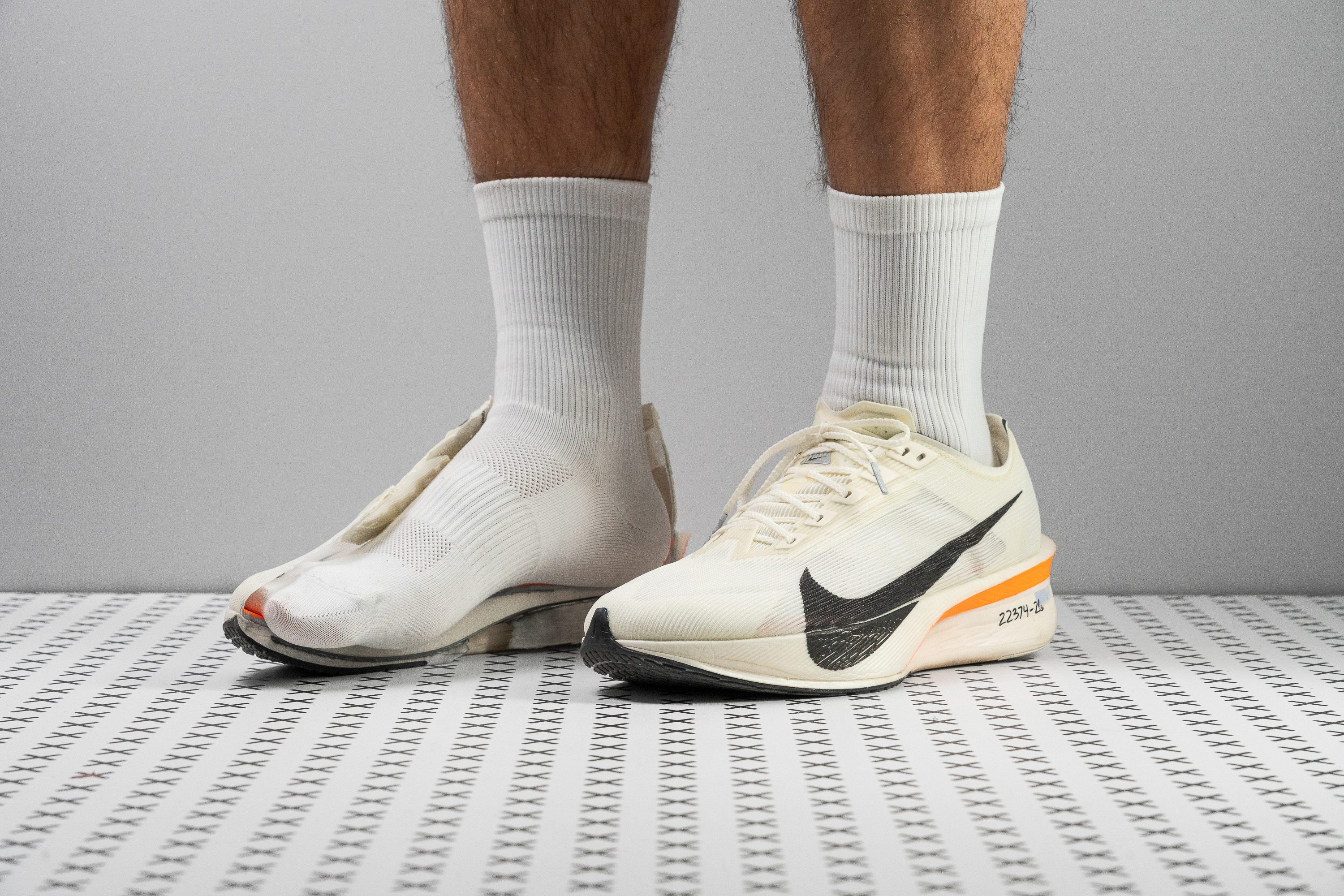





















































What makes it the best?
We experienced otherworldly speed in our runs with the Nike Vaporfly 4. It primed our legs to beat personal bests with its explosive power and gentle midsole. Among carbon-plated running shoes in our lab, it stands out for its exceptional weightlessness.
Weighing just 5.9 oz (166g), this supershoe is remarkably lighter than the average 7.3 oz (207g) racer in our lab. It feels almost invisible on foot, yet we’re reminded of its presence with every springy takeoff. It features the spoon-shaped Flyplate, which ensures massive energy return through its stiffness. Our bend test confirms it’s a powerhouse, emerging 20.0% stiffer than average.
Complementing the responsiveness is the soft and dynamic ZoomX midsole. Its energy return scores in the lab are through the roof, with 78.1% in the heel and 74.5% in the forefoot. Our caliper reveals a moderate 34.1/25.5 mm stack that will make all types of footstrikers feel well-protected. Plus, our shock absorption test returns an impressive 137 SA in the heel, validating its stress-reducing cushioning.
Comfort skyrockets to another level with its remarkably breathable upper. Its high 4/5 rating on our smoke test mirrored the pleasant ventilation we had in our runs.
However, this performance-oriented shoe runs narrower than average. At only 110.6/77.0 mm, we cannot recommend this pair to those with wide feet or stability needs.
Pros
- 13% lighter than the Vaporfly 3
- Awesome for 5K, 10K and 21K races
- Full ZoomX midsole
- Spring-loaded carbon-fiber Flyplate
- Fantastic lockdown with premium laces
- Moderate rocker for a more natural ride
- Improved perforated, removable insole
- Better rubber coverage in the forefoot
- Gets improvements from the Alphafly 3
- Great upper featuring breathability and durability
Cons
- Less ideal for marathon racing
- Still lacks the snappy feel of the Vaporfly 1&2
- Narrow midfoot and heel limit stability
Best carbon-plated running shoes for heel strikers
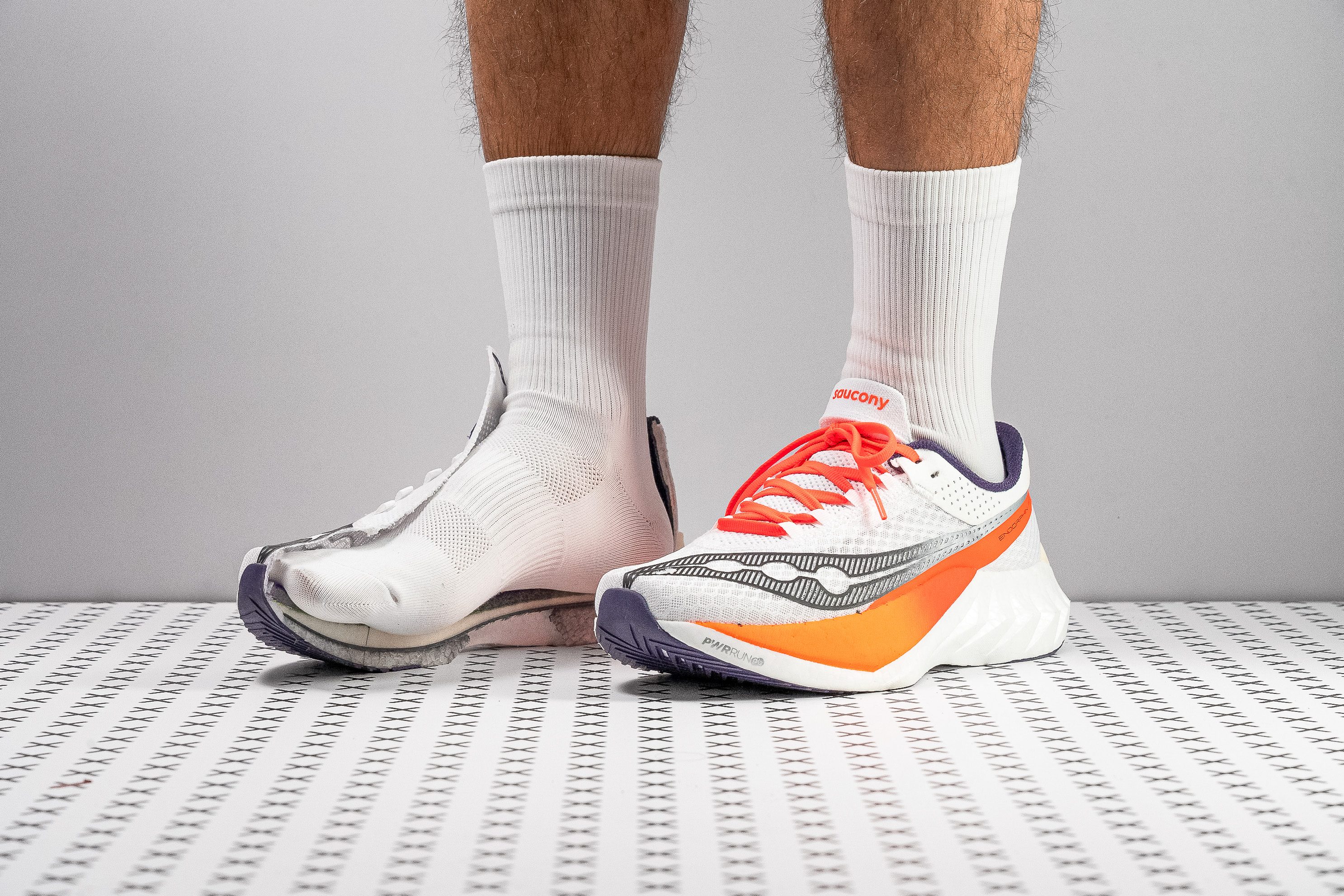
























































What makes it the best?
We deeply enjoyed our runs with the Saucony Endorphin Pro 4. Its dynamic midsole has the optimal blend of impact protection and support, while the carbon plate’s Speedroll technology ensures smooth strides and steady responsiveness. Even our lab can’t deny it’s the ultimate carbon plate running shoe for heel strikers.
No matter how fast or far we ran, the 38.1 mm heel stack dampened landing impact. Paired with a 28.6 mm forefoot, the 9.5 mm drop makes the ride more seamless when striking with our rear. The cushion feels exceptionally bouncy yet stable thanks to the dual-density foam: a soft 18.5 HA layer for comfort and a firmer 22.0 HA layer for support.
At the core of the midsole is an ultra-stiff S-shaped carbon plate, gracing our runs with insane energy return. Checking for its stiffness in our bend test, it emerged 136.6% more resistant than average, explaining its power output.
Besides the shoe’s Speedroll technology, its light build keeps the feeling effortless. Our scales show it’s only 7.8 oz (220g), 17.0% lighter than the average running shoe. Adding to its airy feel is the breezy upper that excelled on our breathability test with a perfect rating.
However, while EP4 is undoubtedly a racer, other competitors may be quicker. For runners chasing PBs by the second, we recommend exploring elsewhere.
Pros
- Durable upper and outsole
- Spacious upper fit
- Enhanced midsole comfort
- Great value at $225 for a supershoe
- Versatile across all paces
- Ideal for heel strikers
- More stable than ever
Cons
- Slightly heavier than v3
- Less suited for forefoot strikers
- Competitors may feel quicker
Best affordable carbon-plated running shoes




















































What makes it the best?
While our current lab-tested carbon plate running shoe costs $222, the Nike Zoom Fly 6 offers impressive energy return and limitless comfort for only $170. It proved to be an awesome all-in-one shoe in our runs—from endurance training to speed intervals, to race day—making it our best affordable pick from the carbon plate roster.
The Flyplate adds both responsiveness and support to our runs without being too stiff. Its design in the heel and midfoot feels more forgiving and offers smooth transitions, making it an awesome training partner even for slower days. In our bend test, it only emerged 25.9% stiffer than average, while most counterparts scored much higher.
The massive 39.7/30.1 mm stack delivers protection for any foot strike and distance. Made of ZoomX cushioning, it feels remarkably bouncy with a hint of plushness, proved by our 16.1 HA durometer rating.
Not only is Zoom Fly 6 easy on the wallet, but it also feels light on foot. It has a streamlined build that reduced its weight to 8.8 oz (248g), 6.8% below average. However, the toebox area was sacrificed as well and feels cramped. If this is a drawback, we recommend exploring more accommodating options.
Pros
- The Zoom Fly is back!
- Fairly priced
- Versatile, performance-ready supertrainer
- Reasonable weight
- Can handle all paces
- Comfortable upper
- Outstanding durability
- Amazing for tempo and marathon workouts
Cons
- Toebox is narrow and restrictive
- SR-02 foam lacks bounce
- Could be more stable
Best carbon-plated running shoes for trail
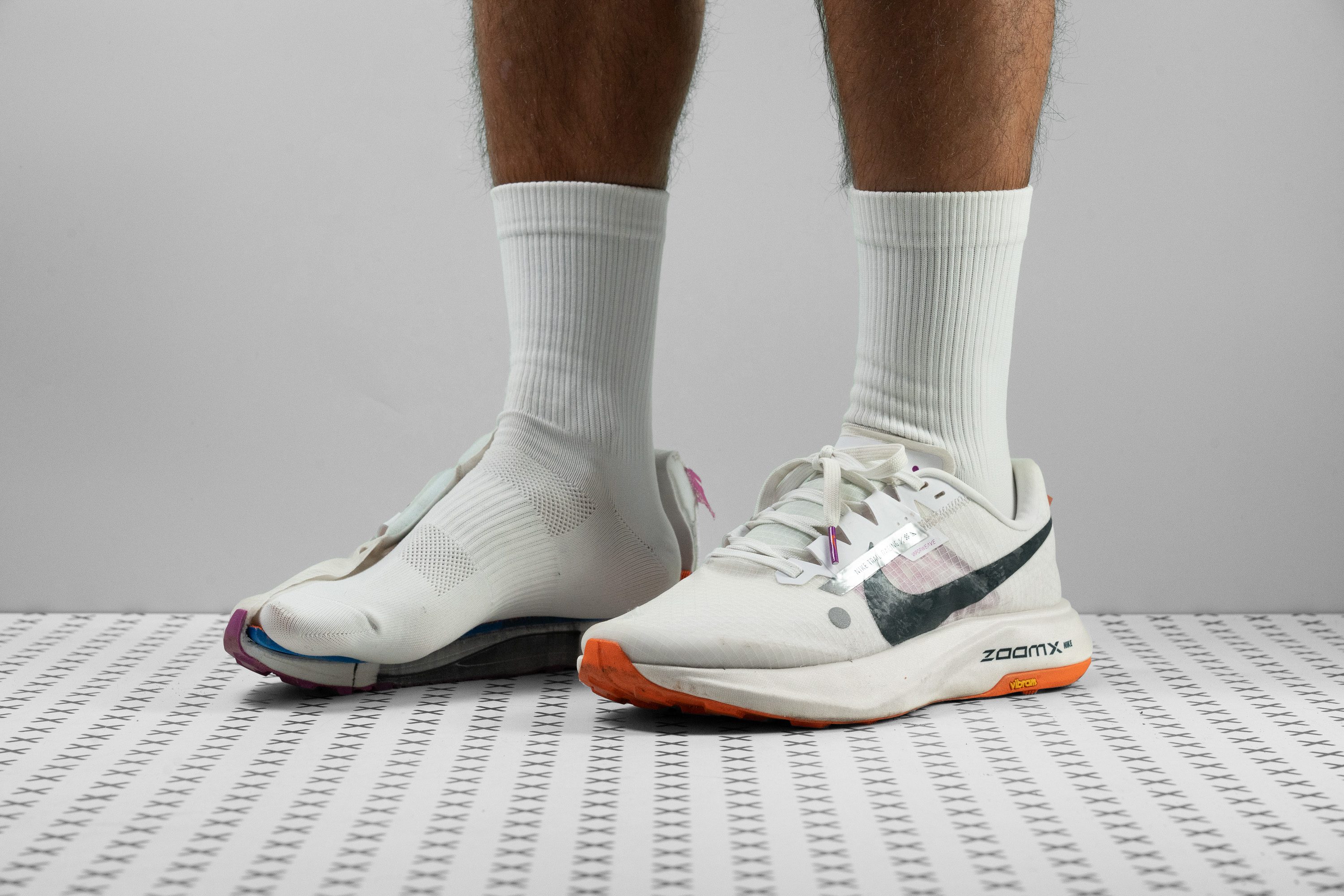



















































What makes it the best?
The Nike Ultrafly is a standout among carbon plate running shoes and is ultimately tailored for trail running, proven by our outdoor runs and lab tests. We found it a reliable endurance trail partner with immense comfort, exhilarating speed, and notable stability. Ultrafly makes long journeys feel effortless, allowing us to immerse ourselves in our runs worry-free.
The ethereal ZoomX midsole feels like magic, offering gentle landings and electric toe-offs. We can’t help but emphasize how luscious and buttery smooth the ZoomX foam is. With a higher and softer stack than average, the ride feels enjoyable at any pace and distance. Our durometer confirms our observation, emerging 56.8% softer than average.
Ultrafly is proof that comfort doesn’t have to sacrifice speed. With a rigid carbon plate in its midsole, it delivers boundless energy return. Our bend test confirms it’s 44.1% stiffer than average, allowing us to speed through moderate trails without worries as the Vibram outsole and 3.0 mm lugs ensure our steady grip.
Meanwhile, the vast 122.1/93.4 mm midsole ensures surefooted landings. The extra width in the forefoot and heel can accommodate wide feet and even support mild pronation.
To our dismay, Ultrafly is not a good place to be in during long summer days. The Vaporweave upper lacks breathability, which can lead to hotspots and icky sweaty feet in tropical weather.
Pros
- Optimized for trail races
- Accommodates wide feet with ease
- Full-length, responsive Pebax midsole
- Equipped with a Vibram Megagrip outsole
- Ideal for heel strikers
- Offers outstanding comfort
- Remarkably stable
- Suitable for 100-mile races
Cons
- The Vaporweave upper could be more durable and breathable
- Heavier than expected even for a trail racing shoe
- The $260 price tag might be steep for some
- Limited toebox height
A general recommendation from us is: don’t buy carbon-plated shoes if you’re a beginner. Many things come into play and it’s best if you understand them so that you can make the best out of these very expensive running shoes.
Caution: What you MUST know before buying carbon-plated running shoes
While many reach for the plated shoes because of all the fuss, it’s important to know what you’re getting yourself into. We believe you should know:
- Carbon-plated shoes are not for beginners.
- Some ask for a specific footstrike to be utilized to the fullest which can be an issue for many runners who, for example, are heel strikers and the shoe works best for forefoot strikers.
- The majority of plated shoes are made for racing and such shoes are often uncomfortable at slower paces and especially at jogging and walking.
- These shoes are usually very tall and can be very unstable, especially for overpronators and at sharp turns.
- Many plated shoes were aimed at professional athletes, which is why they work best for fit runners (not too skinny, not overweight).
- It might take time for you to get adjusted to carbon-plated shoes.
- Many of the carbon-plated shoes are not durable. Because of this, runners usually save them for the big day (races).
- Running shoes with a carbon-fiber plate are expensive.
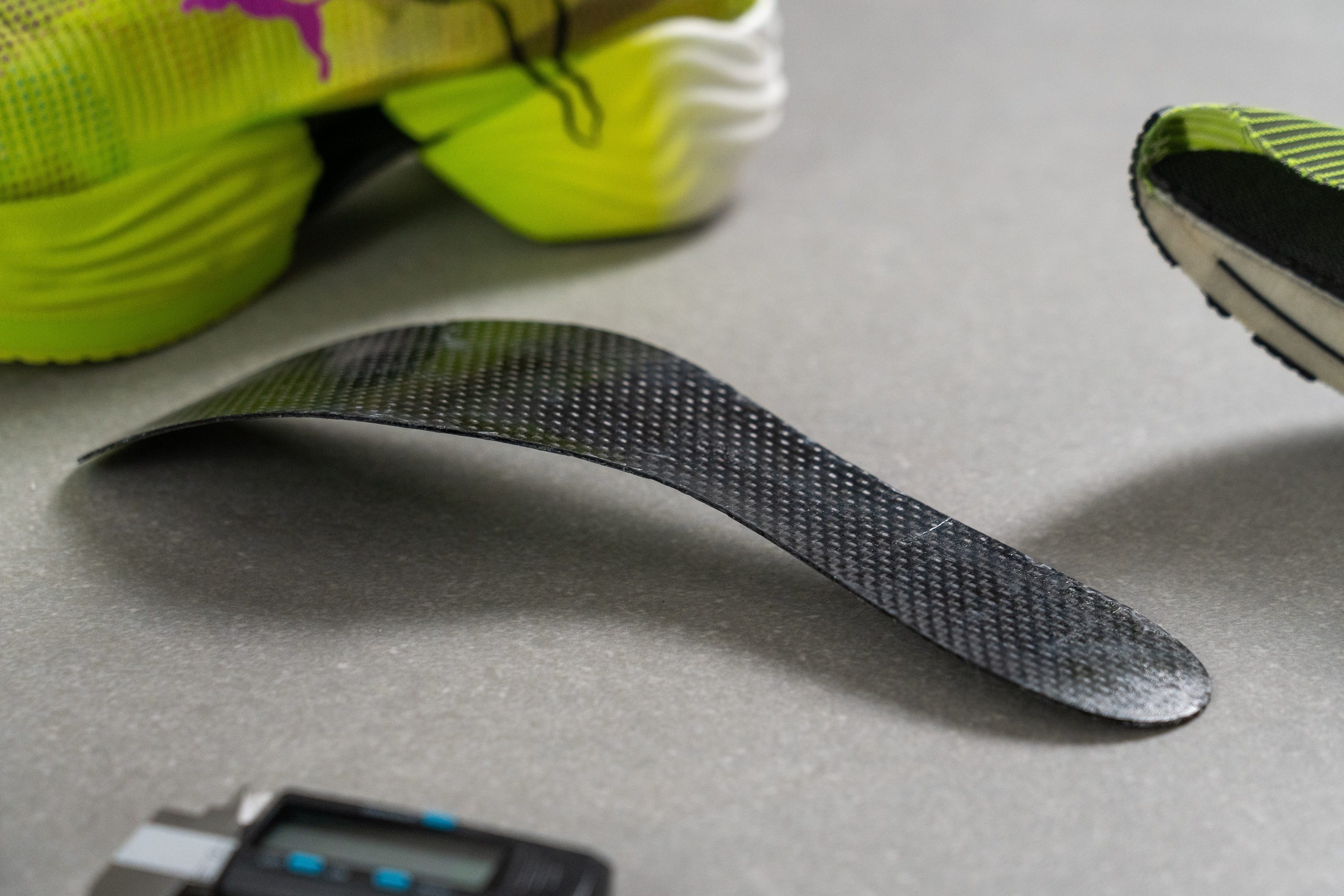
Why having a carbon plate is NOT enough
Carbon-fiber plates are known as THE thing to have in your running shoes if you’re aiming for another PB. However, what people usually take out of the equation is the foam.
The expected advancements can happen, but they have to involve premium foam, not just a carbon plate.
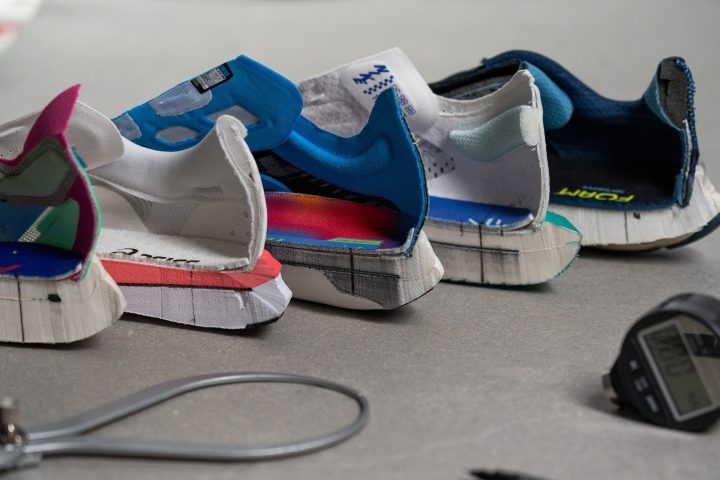
Studies have supported this, showing that only shoes with premium foam (and a plate) could match the Vaporfly. This study specifically analyzes runners’ performance in 8 different shoes, and we recommend reading it.
Carbon-fiber plate was cut in half when the shoe was cut in half
If foams are something that interests you and you want to dig deeper, there’s no more comprehensive guide out there but ours and it features all the possible details and lab data: The ultimate guide to running shoe foams.
What to expect from running shoes with a carbon-fiber plate
Here are 6 things to look forward to or to look out for when it comes to carbon-plated running shoes:
- They are usually lightweight.
- Softness! They are usually very soft yet stiff. Before carbon plates, this was not something we were encountering often and it turned out to be a great combo.
- The midsoles can be very narrow and tall, which also means unstable.
- Propulsiveness! THIS is what they are famous for. They push you forward and the transitions feel effortless or much easier at least.
- They are expensive and not so durable.
- Your finish time can get 2-3% better.
4 things to pay attention to when buying carbon-plated running shoes

- Energy return: the higher, the better.
- How unstable is it? If you prefer a more stable ride, look for: a wider base, side walls, sole flares, more structure in the upper.
- Rubber placement on the outsole can indicate if it’s made primarily for forefoot strikers or all strikers.
- Weight. If you’re buying this shoe to break records, go for the featherweight option, if available to you.
We will cover all of these bullets in greater detail below.
Energy return of carbon-plated running shoes
It's all about responsiveness, it's what carbon-plated shoes are basically known for, especially after Nike hitting the shelves with 4%. To test this, we honor the ASTM F1976-13 methodology.
Testing the energy return of running shoes with a carbon-fiber plate
The result of this test tells us how responsive the shoe is or how capable the foam is of bouncing back after being squished at the landing. The higher the result, the better, of course. And, are these carbon-plated shoes actually that better than other shoes when it comes to energy return? Let's look at the numbers:
| Shoe type | Daily | Tempo | Race | Carbon-plated |
| Avg. energy return [%] | 55.0% | 63.2% | 69.5% |
69.3% (all paces) 72.7% (race) |
And, if you're looking for the best out of best, here are the plated shoes that scored the highest on the energy return test in our lab:
Shoes are getting taller: should you jump on this train?
Since the (carbon plate) + (high-stack premium foam) was shown to work wonders, brands started making the shoes taller and taller, not just in the competition realm, but across the board.
Here’s why you should not join the trend or how to make the best of it:
- If you’re running shorter distances (shorter than 5K or 10K), you should take into account that the very tall midsoles are often unstable at cornering.
- If you’re overpronating, you should reconsider very tall running shoes, especially if they are unstable and have no stability features to stabilize the excessive inward rolling of the ankle. While these supershoes sound like a great idea, overpronators just might not enjoy them as much. We wrote a lot about that in the guide on Best shoes for overpronation.
- If you have neutral pronation and log long mileages, you might enjoy the tall midsoles (even >35mm) not just for racing but training as well.
In the chapter below, we discuss how to look for more stability in very tall running shoes.
Tall does not always mean unstable
But, just because the shoes are tall does not mean they are all unstable. There are many ways to make the shoes more stable: firmer foams, wider bases, sole flares (midsole protrusions), sidewalls, etc.
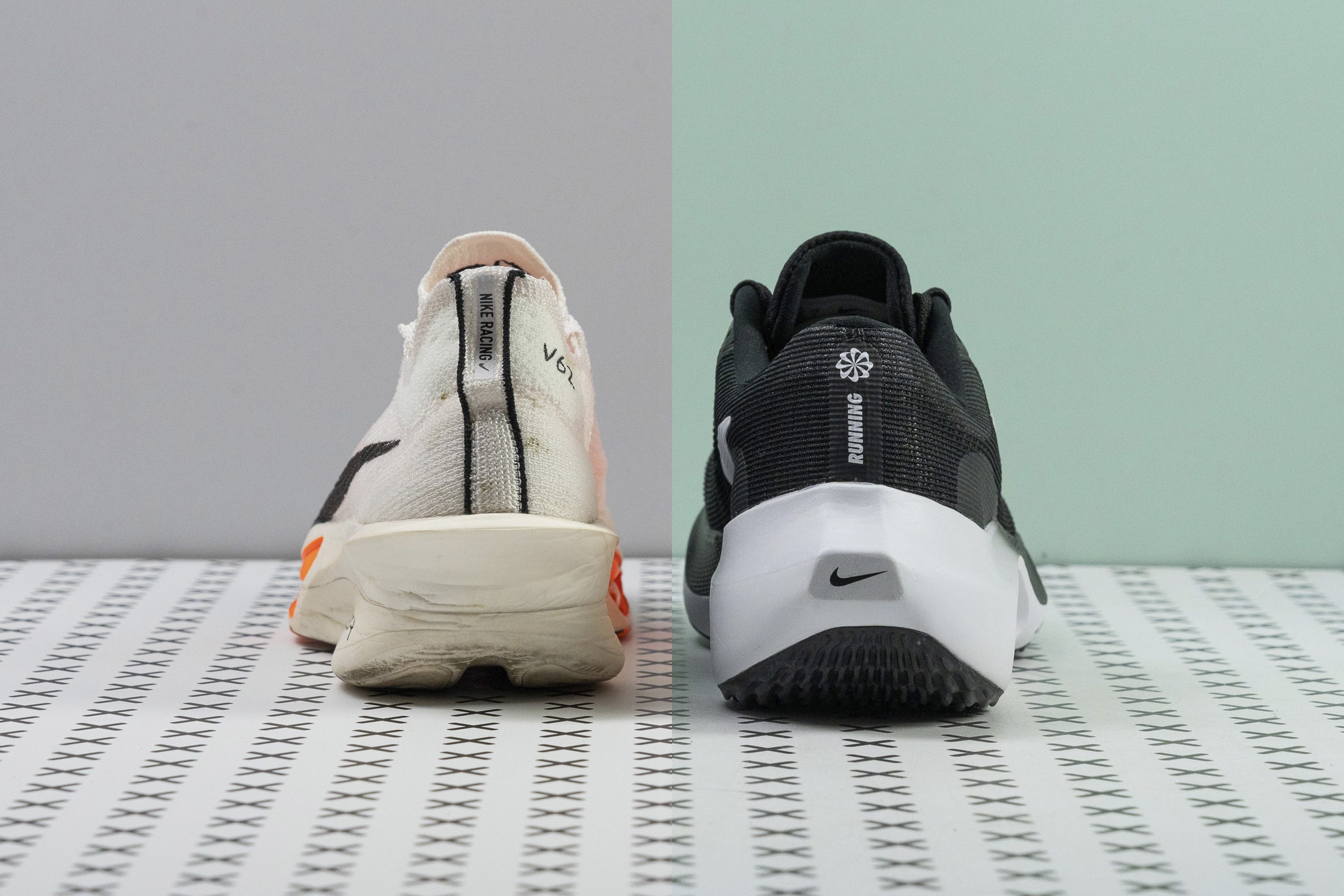
See the image below to find out what you can look for if you want to feel some stability:
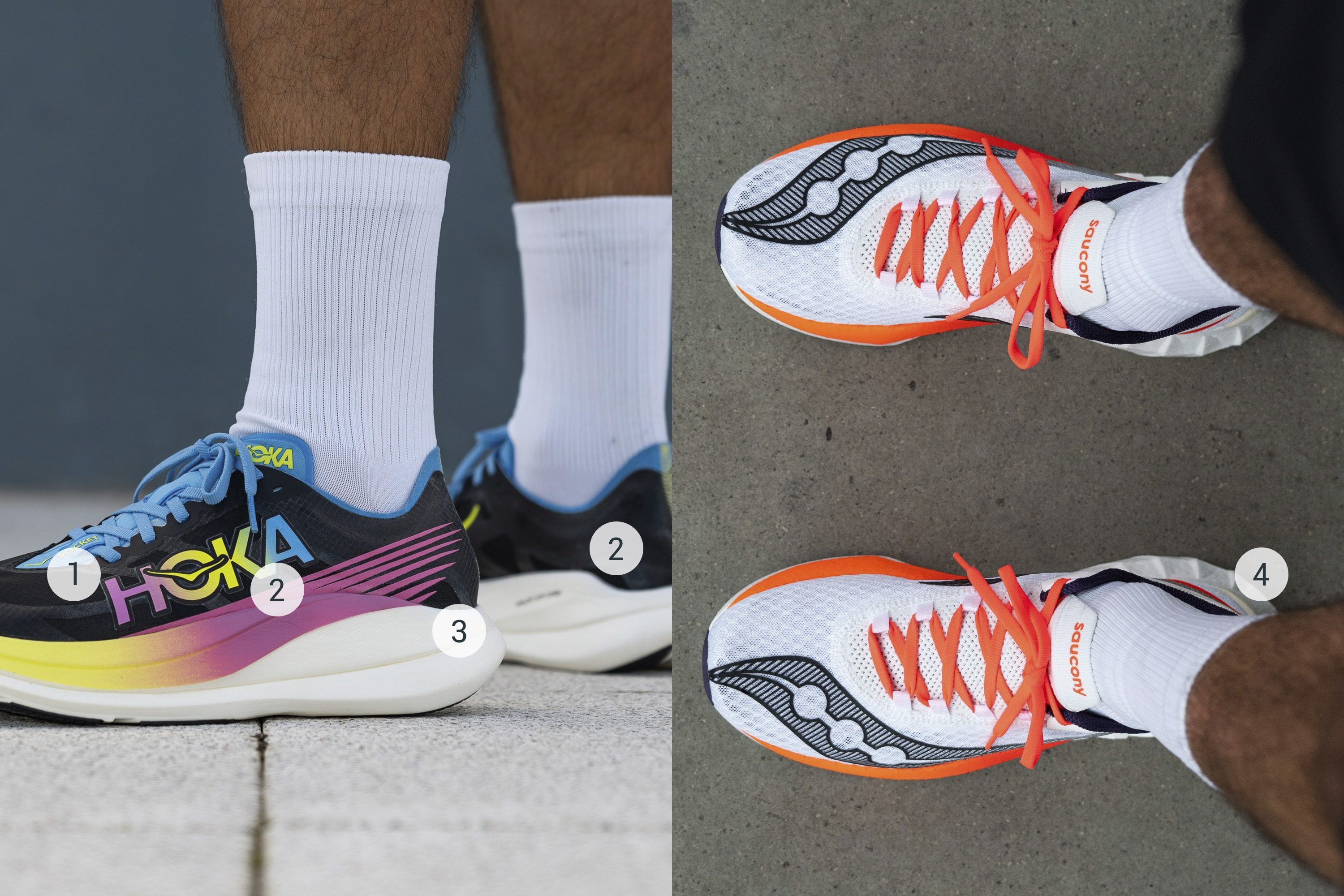
In our lab, we measure the width of the base both at the forefoot and at the heel.

With this in mind, you can use our website to find plated shoes that have a wider base. For that purpose, here we list those width the widest midsoles we’ve measured (these tables are updated automatically with every review we publish):
Which footstrike works best in carbon-plated running shoes
One thing that can tell us which foot strike the shoe was made for is the rubber placement on the outsole. Some shoes have rubber only at the forefoot and exposed midsole at the heel. This implies forefoot strike is the best bet. Others have an even distribution which means any strike is OK.

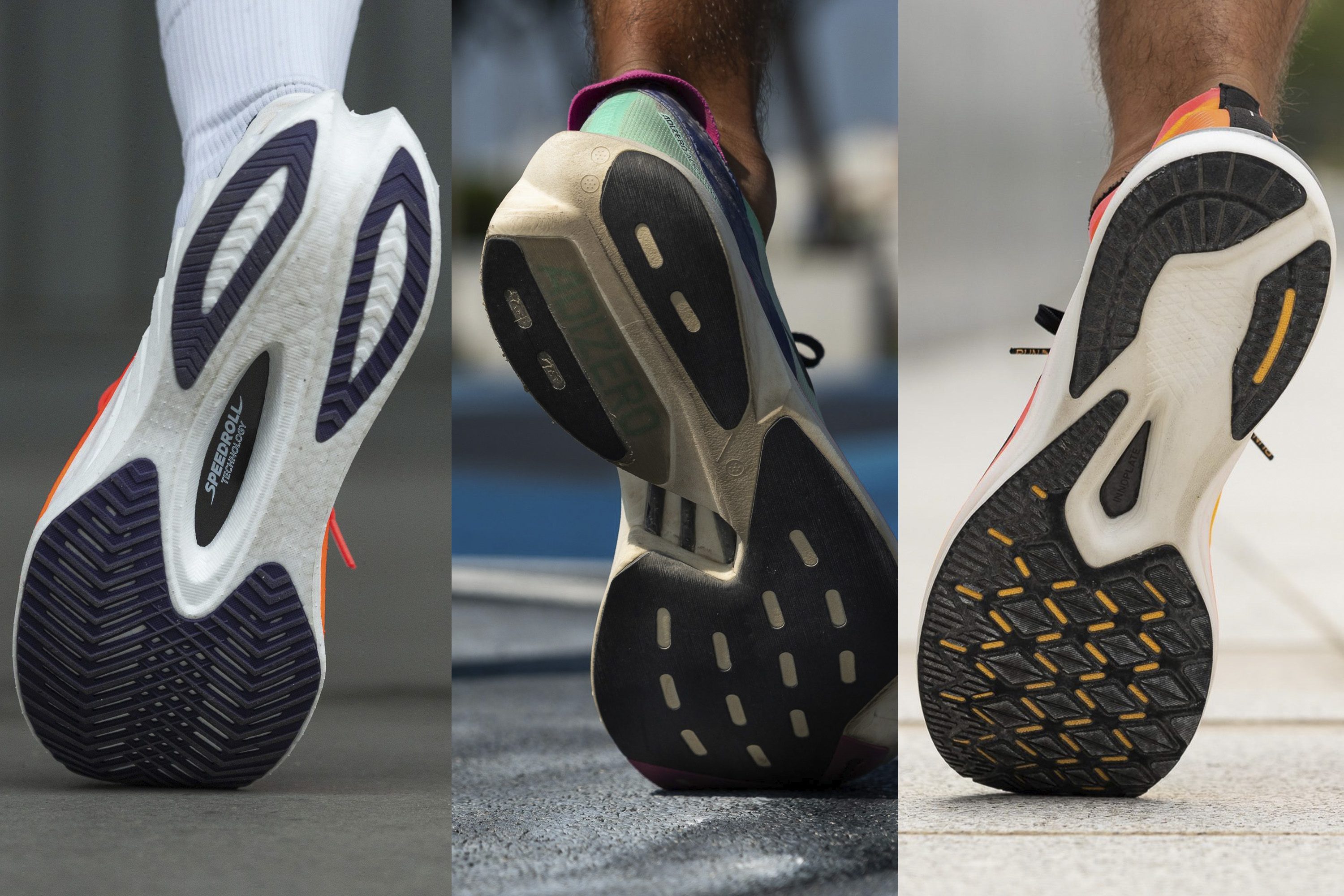
However, looking at Alphafly 3, we can see that the rubber is present only at the forefoot. But, many heel strikers have been using the shoe and enjoying it. For them, the shoe is even less durable, because they land on the exposed midsole which is way less durable than the rubber as seen in our durability test.
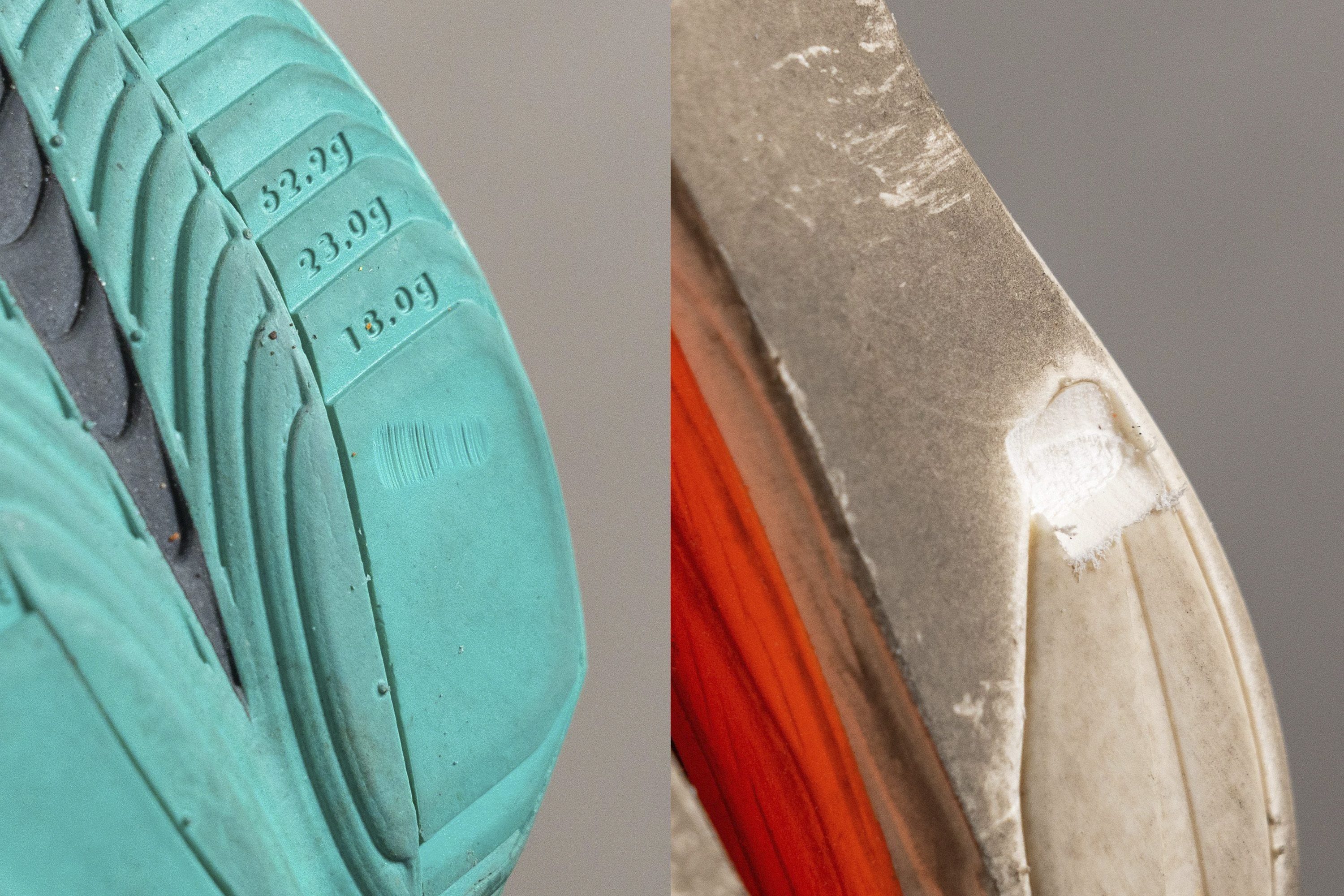
Based on all the findings, many shoes work for all foot strikes. It’s on you to figure out which shoe works best for you. Keep in mind though, that heel-to-toe drop can play an important role here, which is why forefoot strikers usually run in shoes with a heel drop lower than 9mm, and heel strikers aim for 10mm and above.
If you’re not familiar with the heel drop and its role in running, go over to Heel to Toe Drop: The Ultimate Guide.
Why so not durable?
It’s a known fact that carbon-plated shoes are not as durable as other shoes. It comes down to the foam because premium foams don’t last as long as the standard ones. So, either the foam bottoms out (stops being responsive) or the damage at the bottom (be it a rubber or an exposed midsole) is too big.
In our lab, we perform durability tests for: 1. toebox, 2. heel padding, and 3. outsole. We press our Dremel against those 3 surfaces and assess or measure the damage. We correlate this to the durability of each section. To learn more about how we test shoes, visit our Methodology page.
The upper on premium race shoes is usually sock-like, very breathable, and very soft, so we expect it to be less durable.

The same goes for the heel padding, which rarely features a plastic heel counter or a 1cm thick padding. These features are saved for daily trainers, especially stability ones.
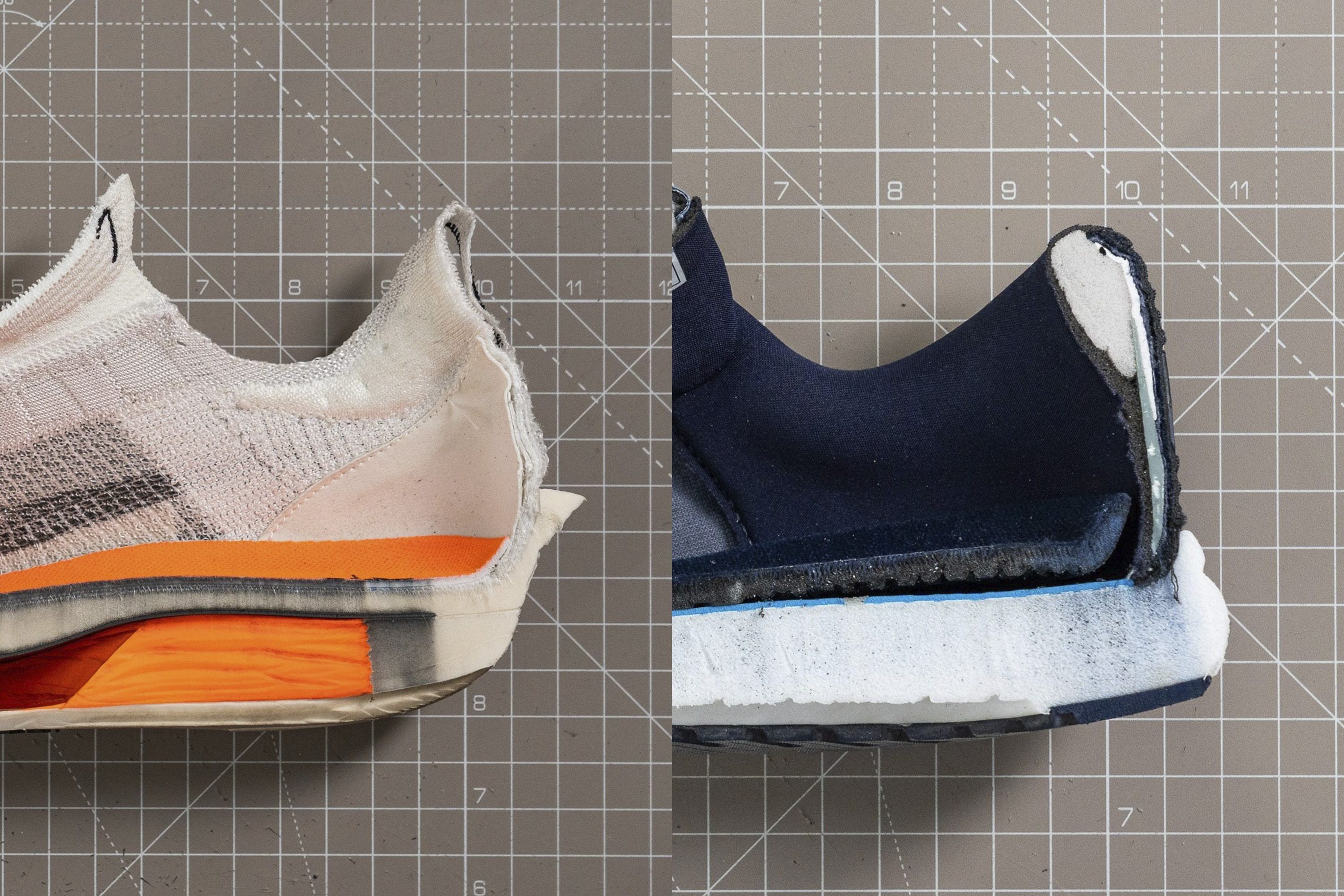
But, as it turns out, even the sock-like heels get to be durable.
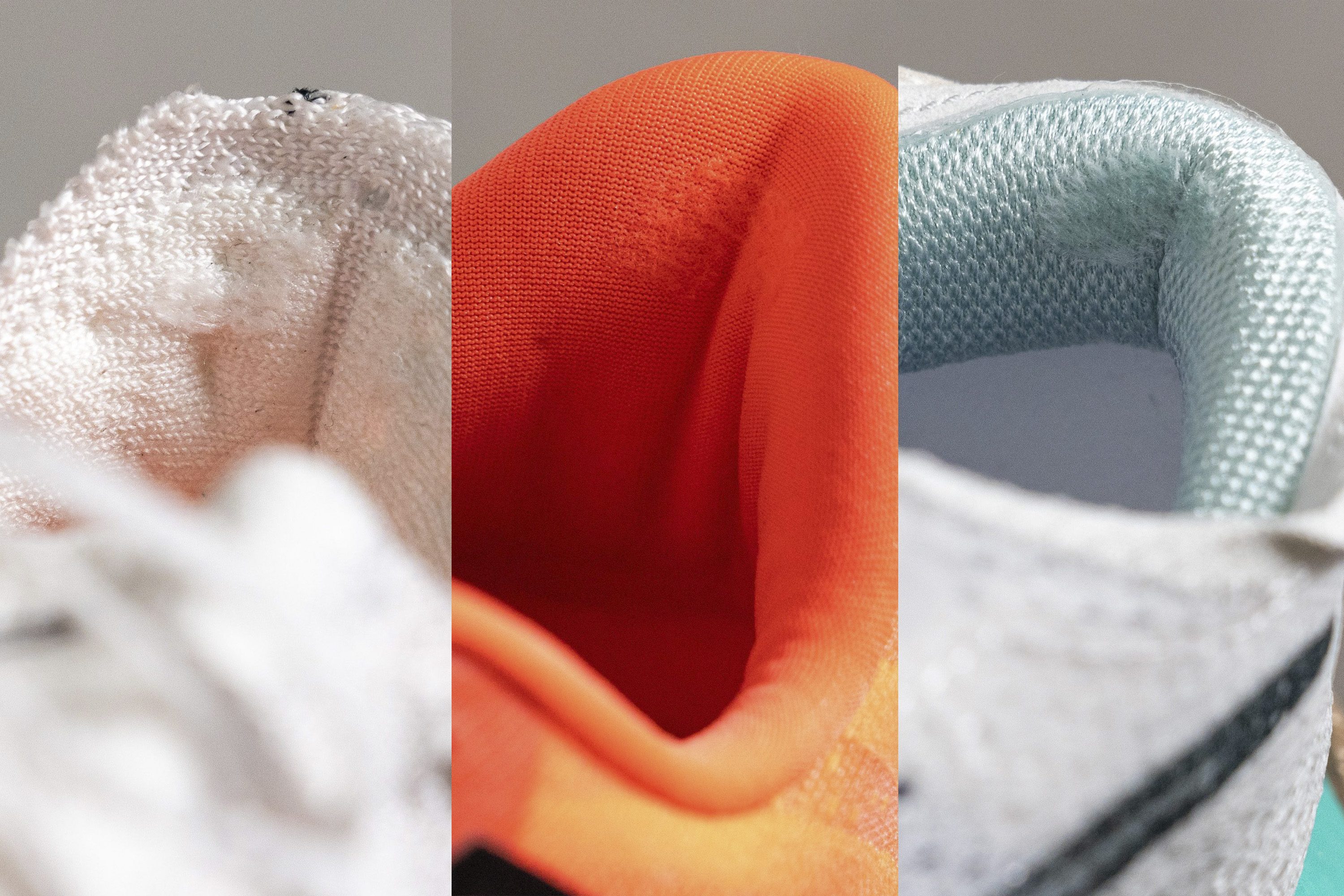
However, when we talk about outsoles, the big issue arises when runners land on the exposed midsole instead on the rubber. We’ve covered this above in the footstrike chapter.
How landing on the exposed midsole in the heel brings even more instability
|
Non-plated shoes |
Carbon-plated shoes |
|
|
Avg. toebox durability |
2.6 | 1.9 |
|
Avg. heel padding durability |
3.1 | 4.3 |
|
Avg. outsole durability |
0.9 | 1.1 |
In the table above, we can see that heel padding is the only part that is more durable in carbon-plated shoes than the rest. The outsole and toebox are, on average, less durable.
For the table below, keep in mind that the toebox and heel padding durability is assessed on a 1-5 scale, so 5/5 is the most durable. For the outsole durability, we measure the depth of the dent our Dremel has made. So, the shallower the dent (lower the numbers), the more durable the outsole.
Stiffness of carbon-plated running shoes
Carbon-plated running shoes are significantly stiffer than the non-plated ones: on average, a force of 13.1N is needed to bend the non-plated competition running shoes to 30 degrees, while the machine shows 20.8N on average when we're testing the stiffness of plated shoes!
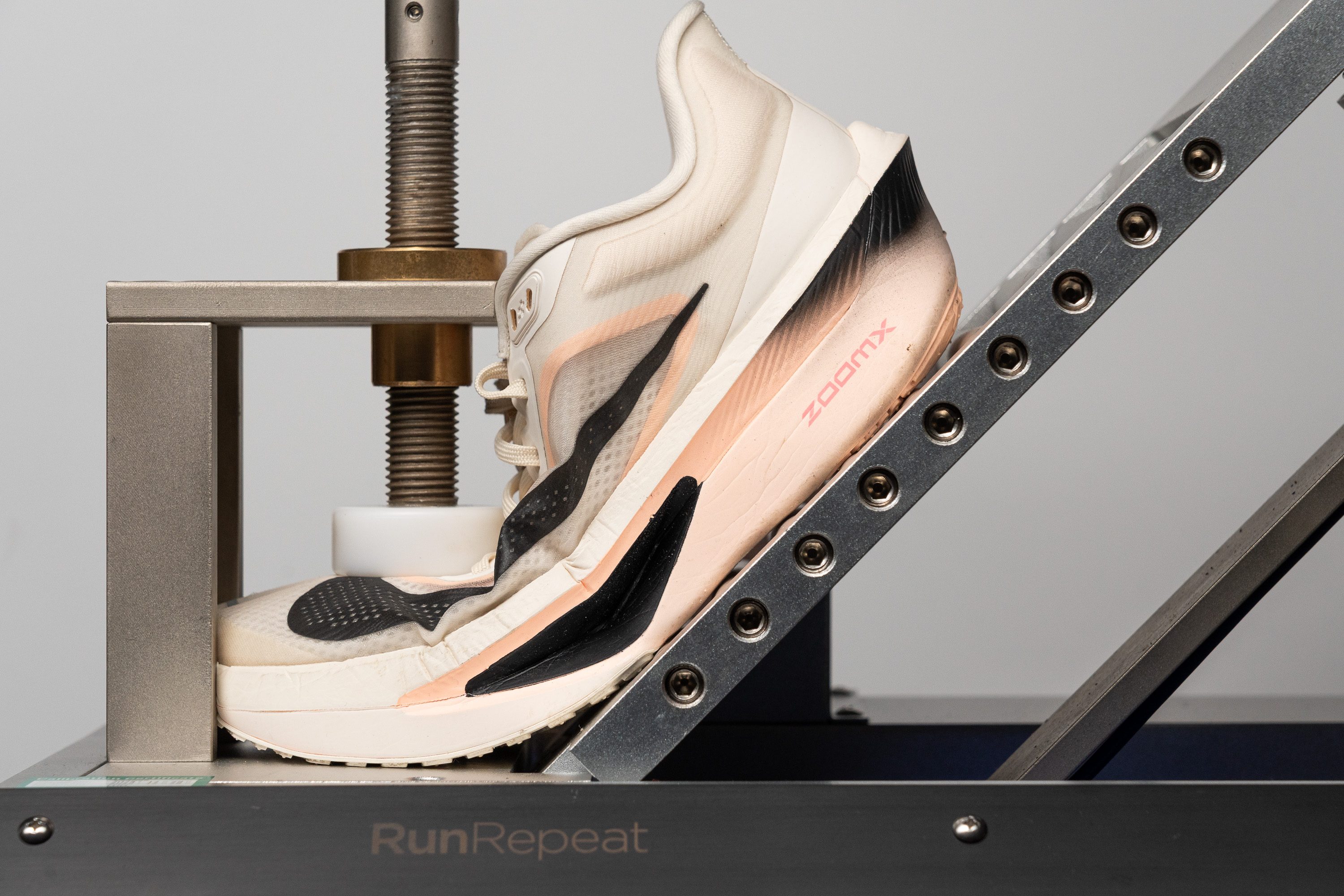
To test how flexible or how stiff running shoes with a carbon-fiber plate are, we first secure the toebox in place. Due to the toe rocker, the heel then lifts from the ground. We adjust the bottom plate so that the heel rests on it and then we bend the shoe to 30 degrees. We measure how much force was needed for this action and the higher the number in Newtons, the stiffer the plated shoe.
Weight of carbon-plated running shoes
They are known for being lightweight but just how lightweight are they really? Based on our lab data:
- The average weight of carbon-plated competition and tempo road shoes: 8.1oz or 229.0g
- The average weight of tempo and competition non-plated road shoes: 7.7oz or 217.5g
- The average weight of all road shoes (excl. carbon-plated ones): 9.5oz or 270.3g
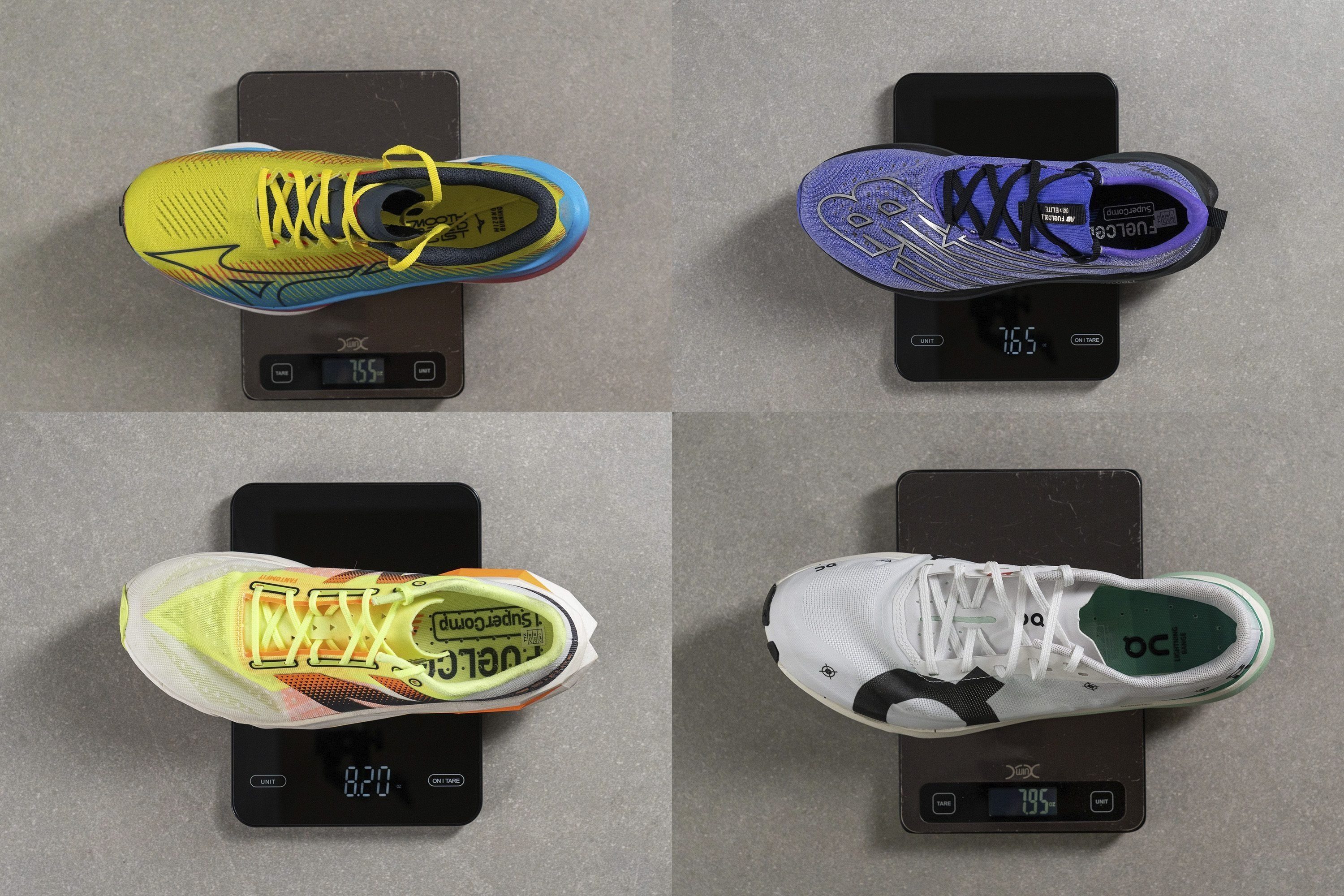
Here are the lightest carbon-plated running shoes:
Design of the carbon-fiber plate
Carbon-fiber plates can be partial or full. When they are partial, their placement can also vary.
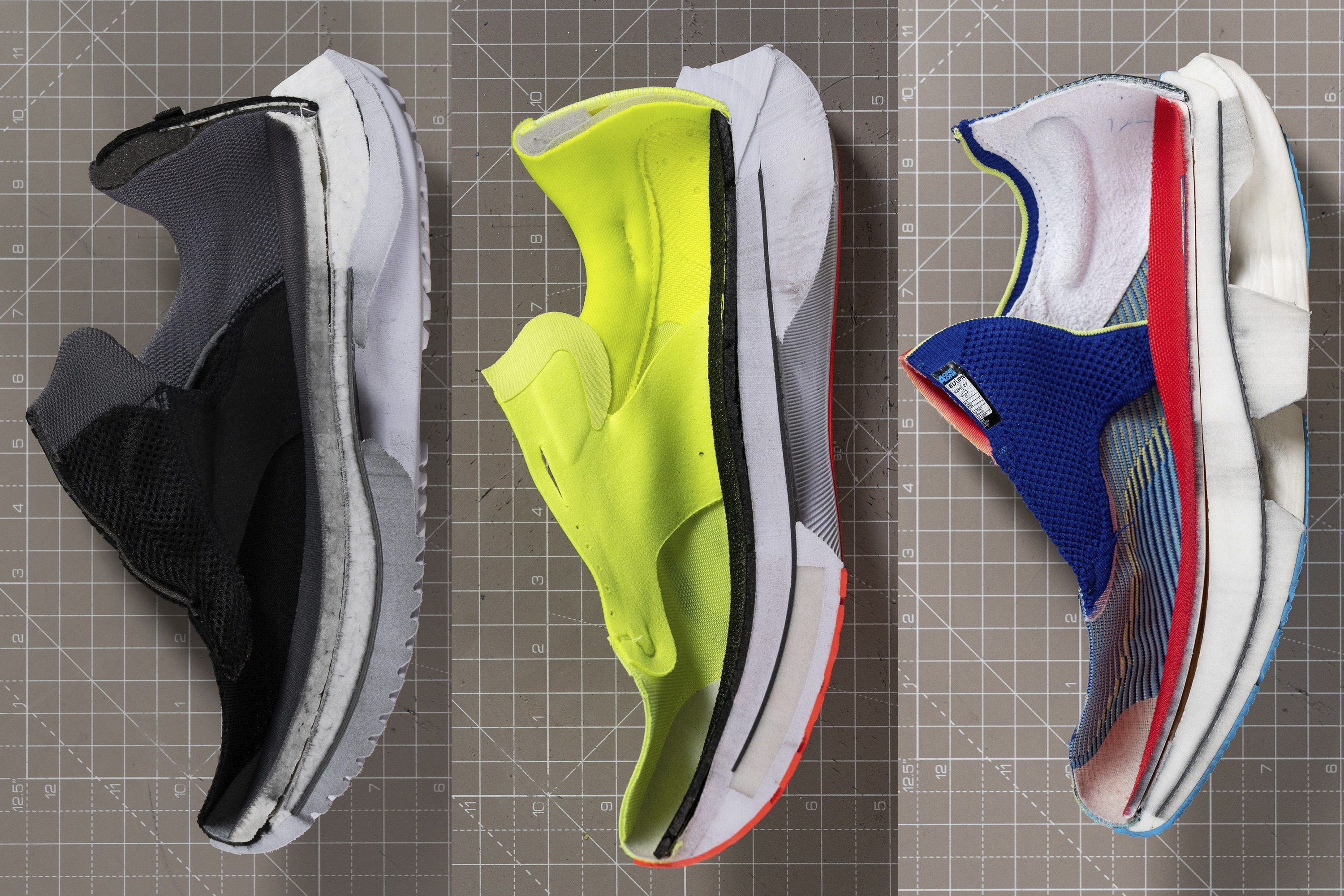
There was a study (Song et al., 2023) that looked at the placement of the carbon-fiber plate and it has shown that thicker plates placed closer to the outsole reduced pressure and strain under the forefoot the most. Carbon-fiber plates embedded in the midsole closer to the insole (and foot) increased stress on metatarsal bones!
The same lead researcher (Song et al., 2024) did a study a year later on the curvature of the carbon plates and found out that both curved and flat plates make force transmission more unfirom, while the curved ones reduced the forefoot pressure more, and they improved how forces were distributed across the metatarsals without increasing bone stress.
It's not just about the length and whether the plate is closer to the insole or to the outsole. The design of the carbon-fiber plate can vary wildly!
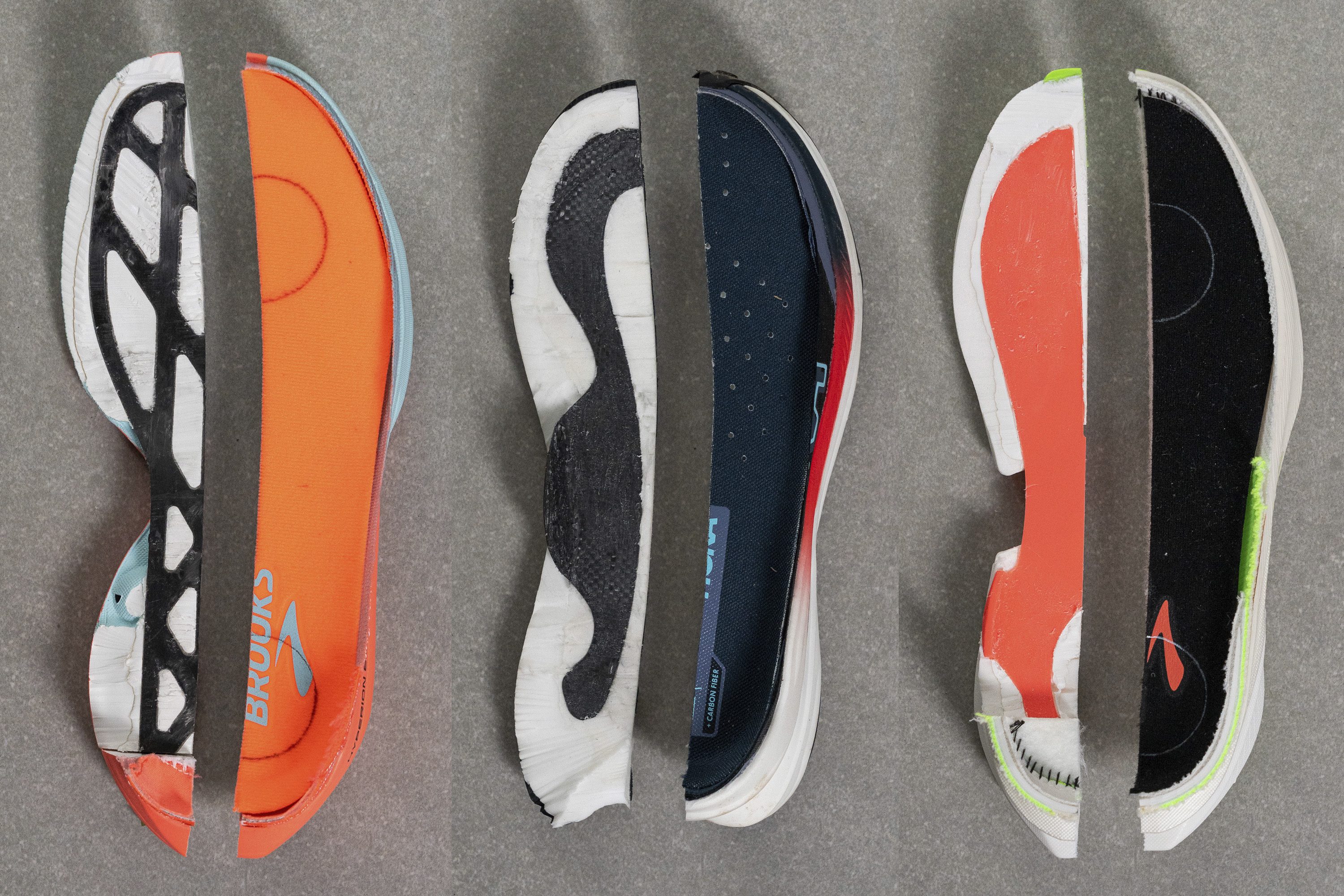
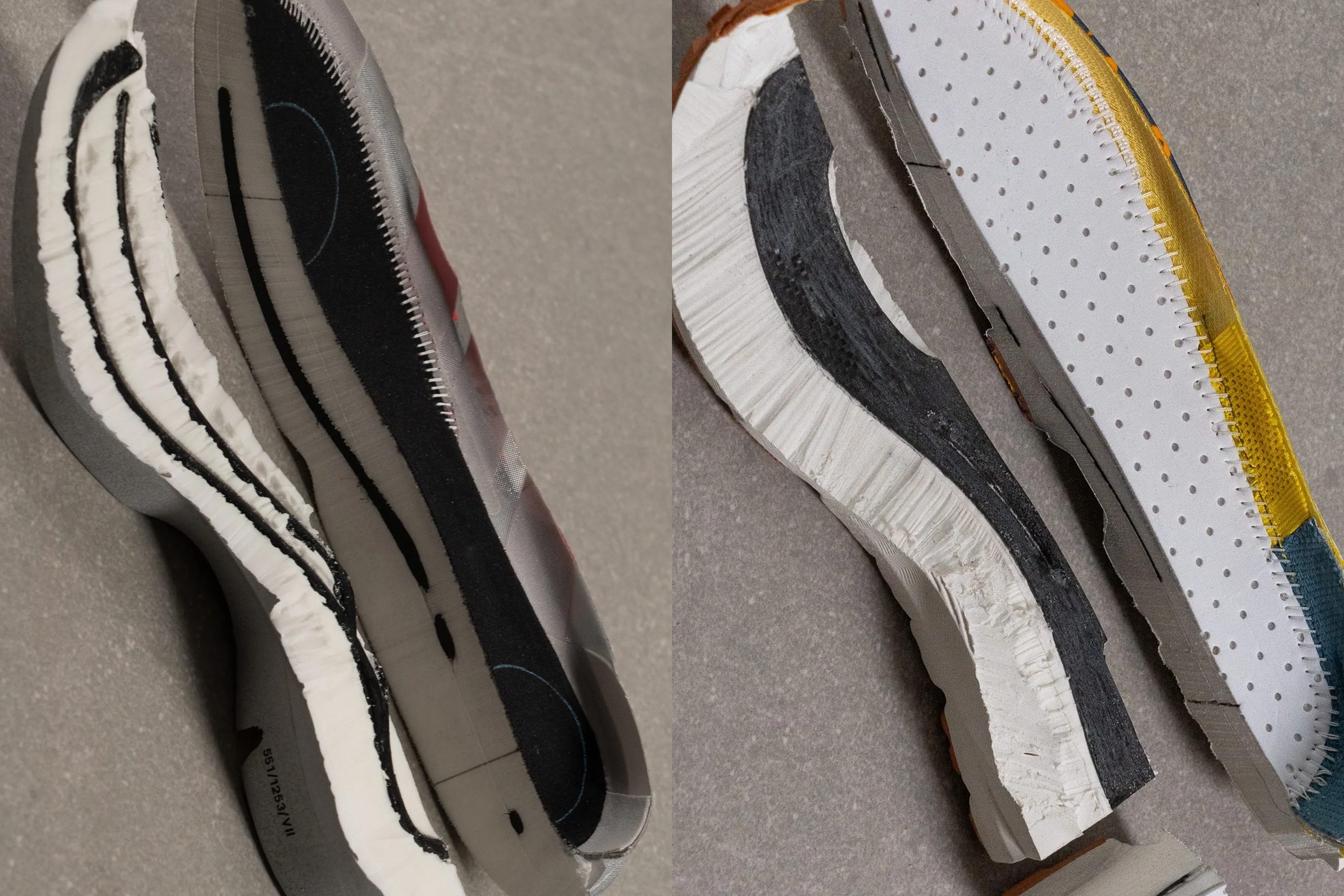
What does it mean for runners?
- Longer plates mean shoes are more torsionally rigid (much less twisting)
- Shorter plates might mean less stability or less pop.
Full-length carbon-fiber plate taken out from the midsole:
How faster can you actually be in carbon-plated running shoes?
First, we had Nike’s claim that the shoes allowed a 4% improvement in running economy. Then, studies confirmed it (Hoogkamer et al. 2017, Barnes et al. 2019).
When we look at running performance, that means 2-3% better finish times. Here’s what that can look like:
| Finish time | 2.5% improved finish time | |
| 5k | 00:34:37 | 00:33:34 |
| 10k | 01:02:08 | 01:00:16 |
| Half marathon | 02:14:59 | 02:10:56 |
| Marathon | 04:26:33 | 04:18:33 |
If you want a much more detailed insight into the world of carbon-plated running shoes, we recommend reading our guide: Carbon-Plated Shoes Cut In Half, Explained and Lab-Tested.
Carbon-plated trail shoes
While it all started with the road shoes, carbon-fiber plates are now very much present in the trail world as well. Not as much, but it seems that they are here to stay.
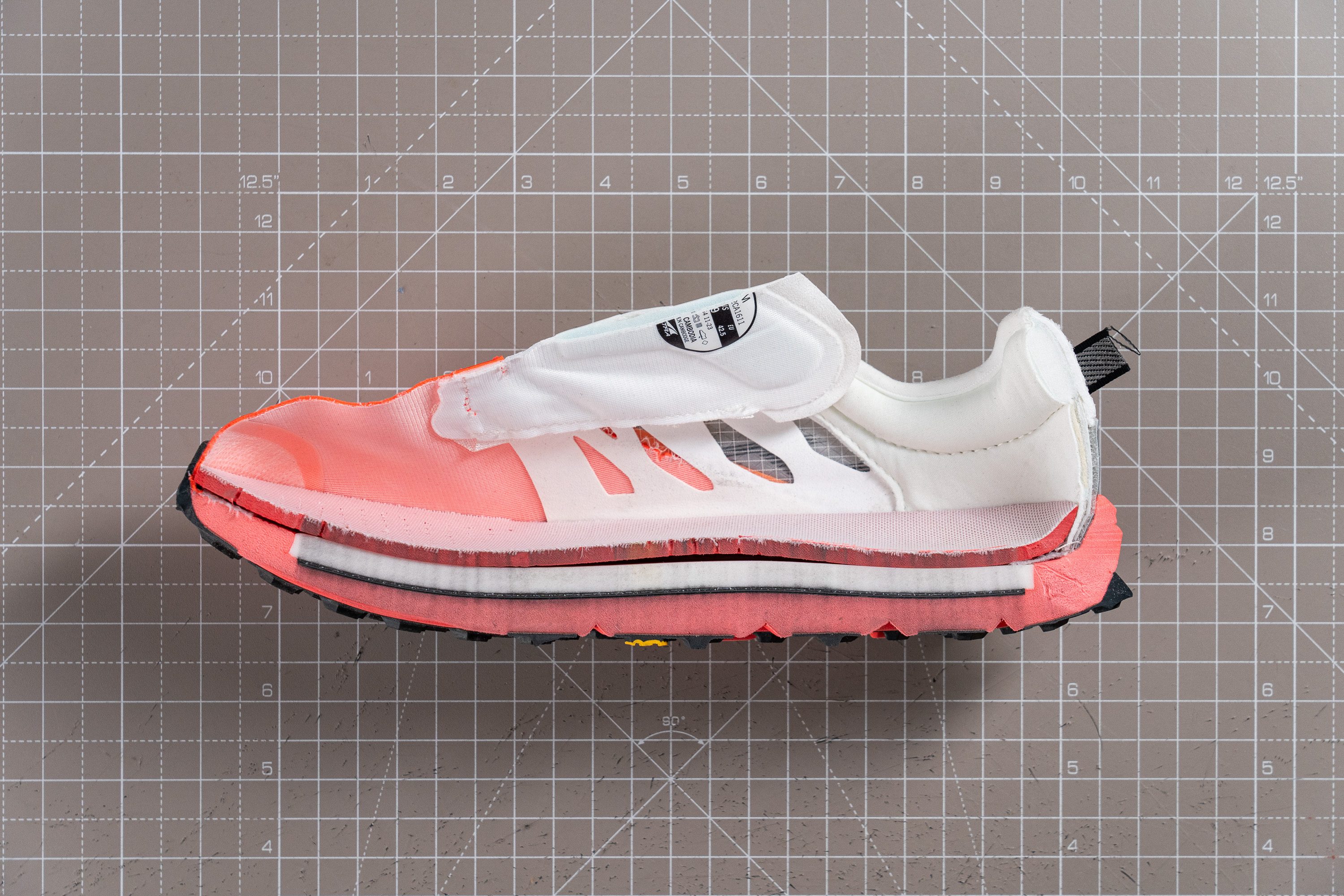
The good thing is, given the nature of the trail terrain, they are not as narrow and tall, because stability is of a much higher priority on trails. That’s one less thing to worry about. It’s on you to find out whether they work for you or not.
Latest scientific research on carbon-plated running shoes
Given how big a deal the introduction of carbon-fiber plates to the world of running shoes is, it's logical that they keep being the subject of research in the scientific world. Let's look at the latest research:
- Researchers compared running biomechanics in 10 elite runners who wore carbon-fiber shoes or traditional shoes. Results have shown that shoes with carbon-fiber plates create a more efficient toe-off because they are more propulsive during push-off. Spencer et al., 2025
- Looking at the design of the carbon-fiber plates, this research has shown that curved plates (compared to the flat ones) may stress away from the hip and knee. Xu et al., 2025
- When comparing 3 types of running shoes: minimalist, conventional cushioned shoes, and advanced running shoes (with carbon-fiber plates), it was shown that carbon-plated shoes reduce ankle loading and lower forces in calf and foot muscles without adding extra load to the other leg parts. Because of this, carbon-plated running shoes may offer a more efficient biomechanics. Kim et al., 2025
- Measuring joint loads and muscle activation while 8 male runners ran at different speeds with and without carbon-plated running shoes, researchers found that plated shoes reduced stress and stiffness at the knee and changed lower-leg muscle activation. This suggests that running shoes with carbon-fiber plates may lower certain injury-related loads during fast running. Yang et al., 2025
- Carbon-fiber insoles are already present on the market and research has shown that they, compared to the plates embedded in the midsoles, do not offer real performance gains. However, subjectively, runners felt as if there was a performance gain because they felt more explosive. Dierickx et al., 2023
- Nike Vaporfly 4% shoes were used for running on the flat surface, uphill, and downhill. It was shown that, compared to traditional racing shoes, Vaporfly reduced energy cost by about 4% on flat terrain and about 3% on uphills. Whiting et al., 2022

